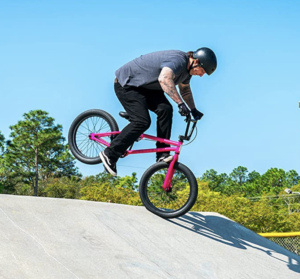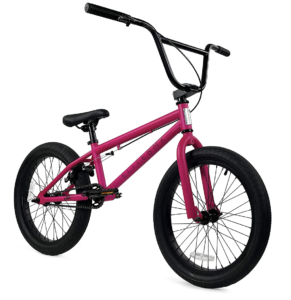
Ever wonder what those “small” bikes are? They are BMX Bikes. Typically, seen in parks amongst the youth and extreme teenagers.
A BMX bike is an off-road sport bicycle used for racing and stunt riding. BMX means “bicycle motocross”.
Though originally denoting a bicycle intended for BMX racing, the term “BMX bike” is now used to encompass race bikes, as well as those used for the dirt, vert, park, street, flatland and BMX freestyle disciplines of BMX.
Different styles Available on Amazon: BMX Bike

BMX frames are made of various types of steel, and aluminum or carbon.
Cheaper, low-end bikes are usually made of steel. High-range bikes are mostly chromoly or high tensile steel, although the latter is noticeably heavier with respect to strength. High-performance BMX bikes use lightweight 4130 chromoly, or generation 3 chromoly.
BMX Bikes are also available in different models/styles:
- Dirt – dirt style are closest to the original bikes. They feature tyres with thicker tread for better grip on potentially loose surfaces.
- Flatland – flatland style bikes have different frame geometry to traditional park BMX bikes because flatland riding requires precise balance on multiple parts of the bike.
- Park – park style bikes (also called vert) are often made lighter by reducing the structural strength of particular areas of the bike, which is possible because park riding does not occur on particularly rough terrain. Brakes may or may not be installed.
- Race – racing style bikes feature a larger front sprocket than other bikes in order to create a high gear ratio, enabling the rider to pedal at high speeds. Racing BMX bikes are required to have brakes.
- Street – modern street style BMX bikes commonly have nylon composite sleeved pegs attached to the axles to enable the rider to grind or balance on various raised obstacles. Metal pegs have fallen out of favor among street riders due to the unkempt nature of street obstacles.
- Also, the street is commonly heavier and stronger than the traditional dirt or park style bikes due to the extra strain encountered with the hard, flat surfaces of street riding. Street riders commonly have no cable brakes to enable the rider to spin the bars without the brake cable getting in the way. Riders use their foot against the top of the back tyre to slow down, or fit a u-brake to the rear with an extended cable or a gyro to allow for full rotation of the bars.
- Good heart health.
- Builds muscles.
- To lose weight.
- Great for mental health.
- Strengthens lower back muscles.
History
BMX started in the early 1970s when children began racing their bicycles on dirt tracks in Southern California, drawing inspiration from the motocross superstars of the time.
The size and availability of the Schwinn Sting-Ray made it the natural bike of choice, since they were easily customized for better handling and performance. BMX racing was a phenomenon by the mid-1970s. Children were racing standard road bikes off-road, around purpose-built tracks in California.
The 1972 motorcycle racing documentary “On Any Sunday” is generally credited with inspiring the movement nationally in the US; its opening scene shows kids riding their Schwinn Stingrays off-road. By the middle of that decade the sport achieved critical mass, and manufacturers began creating bicycles designed especially for the sport.
